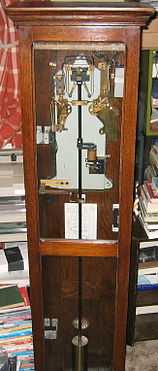Master clock


A master clock is a precision clock that provides timing signals to synchronize slave clocks as part of a clock network. Networks of electric clocks connected by wires to a precision master pendulum clock began to be used in institutions like factories, offices, and schools around 1900. Today many quartz clocks are synchronized by radio signals or internet connections to a worldwide time system called Coordinated Universal Time (UTC) which is governed by master atomic clocks in many countries.
In the days before the availability of such highly accurate reference time many master clocks were an accurate electrically maintained pendulum clock. Thousands of such clocks were installed, in schools, offices, railway networks, telephone exchanges and factories all over the world; they resembled a longcase clock, but had a very robust mechanism and a less ornate case. The clock timing signals, generated by electrical contacts attached to the mechanism, were minute, half minute and sometimes one second electrical pulses, fed to the controlled equipment on pairs of wires. The devices driven could be wall clocks, tower clocks, factory sirens, school bells and occasionally clock chiming mechanisms. Some types, such as the Synchronome had optional extra mechanisms to compare the time of the clock with a standard received from the GPO installation at Rugby, which allowed small weights to be added or removed from the pendulum without interruption. Small weights could also be added or removed manually in the absence of this mechanism again without interruption.
The British Post Office (GPO) used such master clocks in their electromechanical telephone exchanges to generate the call timing pulses necessary to charge telephone subscribers for their calls, and to control sequences of events such as the forcible clearing of connections where the calling subscriber failed to hang up after the called subscriber had done so. The UK had three such manufacturers, all of whom made clocks to the same GPO specification and which used the Hipp Toggle impulse system; these were Gent and Co., of Leicester, Magneta Ltd of Leatherhead in Surrey, and Synchronome Ltd of Alperton, north-west London.
A modern, atomic version of a Master Clock is the large clock ensemble found at the U.S. Naval Observatory [1]



See also
References
External links
| Wikimedia Commons has media related to Master clock. |
- http://www.hvtesla.com/masters/masters_index.html All about electric master and slave clocks
- http://www.natsco.net/clock-systems/products/master-clocks Examples of Master Clock Systems